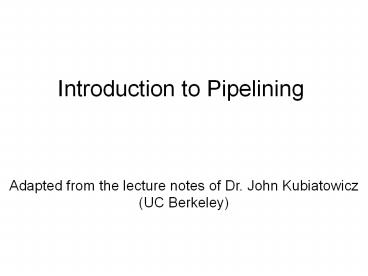Introduction to Pipelining PowerPoint PPT Presentation
Title: Introduction to Pipelining
1
Introduction to Pipelining
- Adapted from the lecture notes of Dr. John
Kubiatowicz (UC Berkeley)
2
Pipelining is Natural!
- Laundry Example
- Ann, Brian, Cathy, Dave each have one load of
clothes to wash, dry, and fold - Washer takes 30 minutes
- Dryer takes 40 minutes
- Folder takes 20 minutes
3
Sequential Laundry
6 PM
Midnight
7
8
9
11
10
Time
30
40
20
30
40
20
30
40
20
30
40
20
T a s k O r d e r
- Sequential laundry takes 6 hours for 4 loads
4
Pipelined Laundry Start work ASAP
6 PM
Midnight
7
8
9
11
10
Time
T a s k O r d e r
- Pipelined laundry takes 3.5 hours for 4 loads
5
Pipelining Lessons
- Latency vs. Throughput
- Question
- What is the latency in both cases ?
- What is the throughput in both cases ?
Pipelining doesnt help latency of single task,
it helps throughput of entire workload
6
Pipelining Lessons contd
- Question
- What is the fastest operation in the example ?
- What is the slowest operation in the example
Pipeline rate limited by slowest pipeline stage
7
Pipelining Lessons contd
Multiple tasks operating simultaneously using
different resources
8
Pipelining Lessons contd
- Question
- Would the speedup increase if we had more steps ?
Potential Speedup Number of pipe stages
9
Pipelining Lessons contd
- Washer takes 30 minutes
- Dryer takes 40 minutes
- Folder takes 20 minutes
- Question
- Will it affect if Folder also took 40 minutes
Unbalanced lengths of pipe stages reduces speedup
10
Pipelining Lessons contd
Time to fill pipeline and time to drain it
reduces speedup
11
Five Stages of an Instruction
Cycle 1
Cycle 2
Cycle 3
Cycle 4
Cycle 5
Load
- Ifetch Instruction Fetch
- Fetch the instruction from the Instruction Memory
- Reg/Dec Registers Fetch and Instruction Decode
- Exec Calculate the memory address
- Mem Read the data from the Data Memory
- Wr Write the data back to the register file
12
Conventional Pipelined Execution Representation
Time
Program Flow
13
Example
14
Example contd
- Timepipeline Timenon-pipeline / Pipe stages
- Assumptions
- Stages are perfectly balanced
- Ideal conditions
15
Definitions
- Performance is in units of things per sec
- bigger is better
- If we are primarily concerned with response time
" X is n times faster than Y" means
16
Example contd
- Speedup in this case 24/14 1.7
- Lets add 1000 more instructions
- Time (non-pipelined) 1000 x 8 24 ns 8000 ns
- Time (pipelined) 1000 x 2 14 ns 2014 ns
- Speedup 8000 / 2014 3.98 4 (approx) 8/2
Instruction throughput is important metric (as
opposed to individual instruction) as real
programs execute billions of instructions in
practical case !!!
17
Pipeline Hazards
- Structural Hazard
Program Flow
18
Pipeline Hazard contd
- Control Hazard
- Example
- add 4, 5, 6
- beq 1, 2, 40
- lw 3, 300(0)
19
Pipleline Hazard contd
- Data Hazards
- Example
- add s0, t0, t1
- sub t2, s0, t3
20
Summary Pipelining Lessons
- Pipelining doesnt help latency of single task,
it helps throughput of entire workload - Pipeline rate limited by slowest pipeline stage
- Multiple tasks operating simultaneously using
different resources - Potential speedup Number pipe stages
- Unbalanced lengths of pipe stages reduces speedup
- Time to fill pipeline and time to drain it
reduces speedup - Stall for Dependences
6 PM
7
8
9
Time
T a s k O r d e r
21
Summary of Pipeline Hazards
- Structural Hazards
- Hardware design
- Control Hazard
- Decision based on results
- Data Hazard
- Data Dependency

